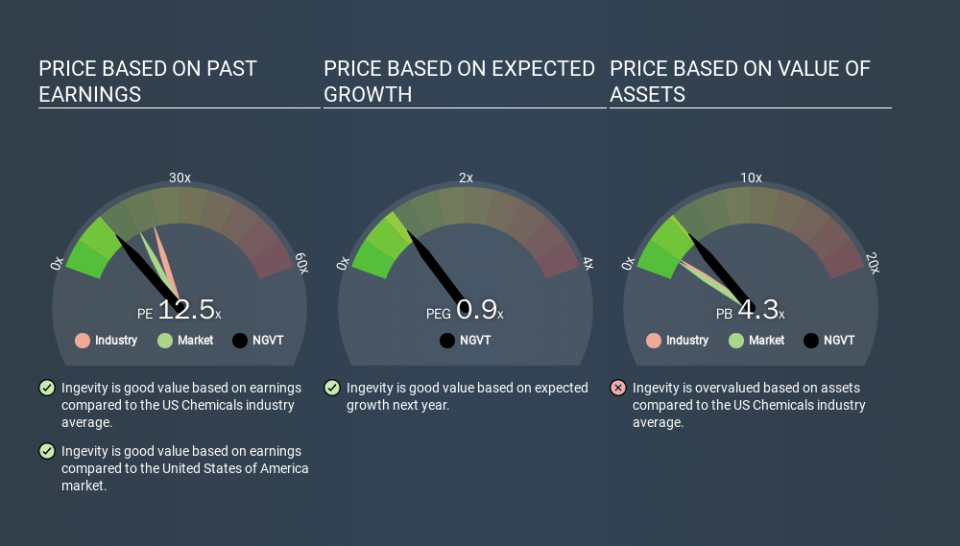A Sliding Share Price Has Us Looking At Ingevity Corporation's (NYSE:NGVT) P/E Ratio

To the annoyance of some shareholders, Ingevity (NYSE:NGVT) shares are down a considerable 32% in the last month. That drop has capped off a tough year for shareholders, with the share price down 56% in that time.
Assuming nothing else has changed, a lower share price makes a stock more attractive to potential buyers. While the market sentiment towards a stock is very changeable, in the long run, the share price will tend to move in the same direction as earnings per share. The implication here is that long term investors have an opportunity when expectations of a company are too low. Perhaps the simplest way to get a read on investors' expectations of a business is to look at its Price to Earnings Ratio (PE Ratio). A high P/E implies that investors have high expectations of what a company can achieve compared to a company with a low P/E ratio.
View our latest analysis for Ingevity
How Does Ingevity's P/E Ratio Compare To Its Peers?
Ingevity's P/E of 11.55 indicates relatively low sentiment towards the stock. The image below shows that Ingevity has a lower P/E than the average (20.9) P/E for companies in the chemicals industry.
Ingevity's P/E tells us that market participants think it will not fare as well as its peers in the same industry. Since the market seems unimpressed with Ingevity, it's quite possible it could surprise on the upside. If you consider the stock interesting, further research is recommended. For example, I often monitor director buying and selling.
How Growth Rates Impact P/E Ratios
Earnings growth rates have a big influence on P/E ratios. Earnings growth means that in the future the 'E' will be higher. That means unless the share price increases, the P/E will reduce in a few years. A lower P/E should indicate the stock is cheap relative to others -- and that may attract buyers.
Ingevity's earnings per share grew by -9.3% in the last twelve months. And it has bolstered its earnings per share by 7.5% per year over the last five years.
A Limitation: P/E Ratios Ignore Debt and Cash In The Bank
The 'Price' in P/E reflects the market capitalization of the company. In other words, it does not consider any debt or cash that the company may have on the balance sheet. In theory, a company can lower its future P/E ratio by using cash or debt to invest in growth.
While growth expenditure doesn't always pay off, the point is that it is a good option to have; but one that the P/E ratio ignores.
Ingevity's Balance Sheet
Net debt is 49% of Ingevity's market cap. You'd want to be aware of this fact, but it doesn't bother us.
The Verdict On Ingevity's P/E Ratio
Ingevity has a P/E of 11.5. That's below the average in the US market, which is 17.2. EPS grew over the last twelve months, and debt levels are quite reasonable. If growth is sustainable over the long term, then the current P/E ratio may be a sign of good value. What can be absolutely certain is that the market has become significantly less optimistic about Ingevity over the last month, with the P/E ratio falling from 16.9 back then to 11.5 today. For those who don't like to trade against momentum, that could be a warning sign, but a contrarian investor might want to take a closer look.
Investors should be looking to buy stocks that the market is wrong about. If it is underestimating a company, investors can make money by buying and holding the shares until the market corrects itself. So this free report on the analyst consensus forecasts could help you make a master move on this stock.
But note: Ingevity may not be the best stock to buy. So take a peek at this free list of interesting companies with strong recent earnings growth (and a P/E ratio below 20).
If you spot an error that warrants correction, please contact the editor at editorial-team@simplywallst.com. This article by Simply Wall St is general in nature. It does not constitute a recommendation to buy or sell any stock, and does not take account of your objectives, or your financial situation. Simply Wall St has no position in the stocks mentioned.
We aim to bring you long-term focused research analysis driven by fundamental data. Note that our analysis may not factor in the latest price-sensitive company announcements or qualitative material. Thank you for reading.

